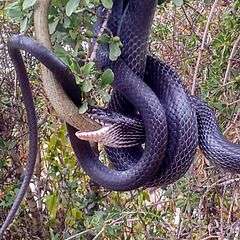Colubridae
| Colubridae Temporal range: Oligocene to Recent | |
|---|---|
 | |
| Caspian whipsnake, Coluber caspius | |
| Scientific classification | |
| Kingdom: | Animalia |
| Phylum: | Chordata |
| Subphylum: | Vertebrata |
| Class: | Reptilia |
| Order: | Squamata |
| Suborder: | Serpentes |
| Infraorder: | Alethinophidia |
| Family: | Colubridae Oppel, 1811 |
The Colubridae (from Latin coluber, snake) are a family of snakes. With 304 genera and 1,938 species, they are the largest snake family, and include about two-thirds of all known living snake species. The earliest species of the family date back to the Oligocene epoch. Colubrid species are found on every continent except Antarctica.[1]
Description
While most colubrids are not venomous (or have venom that is not known to be harmful to humans) and are mostly harmless, a few groups, such as genus Boiga, can produce medically significant bites, while the boomslang, the twig snakes, and the Asian genus Rhabdophis have caused human fatalities.[1][2] Colubridae also include the few species of actually poisonous snakes, notably Rhabdophis tigrinus, the Japanese grass snake or yamakagashi, the difference between poisonous and venomous being that venom requires direct administration (i.e. intravenous injection) and poison can be administered indirectly (i.e. skin contact or ingestion).
Some colubrids are described as opisthoglyphous, meaning they have elongated, grooved teeth located in the back of the upper jaw. The opisthoglyphous dentition appears at least twice in the history of snakes.[2] These are unlike those of vipers and elapids, which are located in the front.[1][2]
Classification
The Colubridae as traditionally defined are not a natural group, as many are more closely related to other groups, such as elapids, than to each other.[3] This family has classically been a "garbage bin taxon"[4] for snakes that do not fit elsewhere.[5] Additional research will be necessary to sort out the relations within this group.

Subfamily Boodontinae (some of which now treated as subfamily Grayiinae of the new Colubridae, others moved to family Lamprophiidae as subfamilies Lamprophiinae and Pseudaspidinae)
- Boaedon
- Bothrolycus
- Bothrophthalmus
- Buhoma (tentatively placed here)
- Chamaelycus
- Dendrolycus
- Dipsina
- Dromophis
- Duberria (tentatively placed here)
- Gonionotophis
- Grayia
- Hormonotus
- Lamprophis
- Lycodonomorphus
- Lycophidion
- Macroprotodon
- Mehelya
- Montaspis (tentatively placed here)
- Pseudaspis
- Pseudoboodon
- Pythonodipsas
- Scaphiophis
Subfamily Calamariinae
- Calamaria
- Calamorhabdium
- Collorhabdium
- Etheridgeum
- Macrocalamus
- Pseudorabdion
- Rabdion
Subfamily Colubrinae – nearly 100 genera
Subfamily Dipsadinae (which some authors rank as family Dipsadidae with subfamilies Dipsadinae and Xenodontinae)
- Adelphicos
- Amastridium
- Atractus
- Calamodontophis (tentatively placed here)
- Carphophis (tentatively placed here)
- Chersodromus
- Coniophanes
- Contia (tentatively placed here)
- Crisantophis (tentatively placed here)
- Cryophis
- Diadophis (tentatively placed here)
- Diaphorolepsis (tentatively placed here)
- Dispholidus
- Dipsas
- Echinanthera (tentatively placed here)
- Emmochliophis (tentatively placed here)
- Enuliophis (tentatively placed here)
- Enulius (tentatively placed here)
- Eridiphas
- Geophis
- Gomesophis (tentatively placed here)
- Hydromorphus (tentatively placed here)
- Hypsiglena
- Imantodes
- Leptodeira
- Ninia
- Nothopsis (tentatively placed here)
- Pliocercus
- Pseudoleptodeira
- Pseudotomodon (tentatively placed here)
- Ptychophis (tentatively placed here)
- Rhadinaea
- Rhadinophanes (tentatively placed here)
- Sibon
- Sibynomorphus
- Synophis (tentatively placed here)
- Tachymenis (tentatively placed here)
- Taeniophallus (tentatively placed here)
- Tantalophis (tentatively placed here)
- Thamnodynastes (tentatively placed here)
- Tomodon (tentatively placed here)
- Tretanorhinus
- Trimetopon
- Tropidodipsas
- Urotheca
- Xenopholis (tentatively placed here)
Subfamily Homalopsinae (now family Homalopsidae) – about 10 genera
Subfamily Natricinae (which some authors rank as family Natricidae) - about 30 genera
- Adelophis
- Afronatrix
- Amphiesma
- Amphiesmoides
- Anoplohydrus
- Aspidura
- Atretium
- Balanophis
- Clonophis
- Hologerrhum
- Hydrablabes
- Hydraethiops
- Iguanognathus
- Macropisthodon
- Natrix
- Nerodia
- Opisthotropis
- Parahelicops
- Pararhabdophis
- Regina
- Rhabdophis
- Seminatrix
- Sinonatrix
- Storeria
- Thamnophis
- Tropidoclonion
- Tropidonophis
- Virginia
- Xylophis
- Xenochrophis
Subfamily Pareatinae (now family Pareatidae) - three genera
Subfamily Psammophiinae (now a subfamily of Lamprophiidae)
- Hemirhagerrhis
- Malpolon
- Mimophis
- Psammophis
- Psammophylax
- Rhamphiophis
Subfamily Pseudoxenodontinae (which some authors rank as family Pseudoxenodontidae)
Subfamily Pseudoxyrhophiinae (now a subfamily of Lamprophiidae) – about 20 genera
Subfamily Xenoderminae (now family Xenodermidae, sometimes incorrectly spelled Xenodermatidae)
- Achalinus
- Fimbrios
- Parafimbrios
- Stoliczkia
- Xenodermus
- Xylophis
Subfamily Xenodontinae (which some authors put in the new Dipsadidae family) – some 55–60 genera
- Blythia
- Cercaspis
- Cyclocorus
- Elapoidis
- Gongylosoma
- Haplocercus
- Helophis
- Myersophis
- Omoadiphas
- Oreocalamus
- Poecilopholis
- Rhabdops
- Tetralepis
- Thermophis
- Trachischium
References
- 1 2 3 Bauer, Aaron M. (1998). Cogger, H.G.; Zweifel, R.G., eds. Encyclopedia of Reptiles and Amphibians. San Diego: Academic Press. pp. 188–195. ISBN 0-12-178560-2.
- 1 2 3 Bruna Azara, C. (1995). "Animales venenosos. Vertebrados terrestres venenosos peligrosos para el ser humano en España" (PDF). Boletín de la S.E.A. 11: 32–40.
- ↑ Lawson, R; Slowinski, J.B.; Crother, B.I.; Burbrink, F.T. (2005). "Phylogeny of the Colubroidea (Serpentes): New evidence from mitochondrial and nuclear genes" (PDF). Molecular Phylogenetics and Evolution. 37: 581–601. doi:10.1016/j.ympev.2005.07.016. PMID 16172004.
- ↑ Scott A Weinstein; David A. Warrell; Julian White; Daniel E Keyler (20 June 2011). “Venomous Bites from Non-Venomous Snakes: A Critical Analysis of Risk and Management of “Colubrid Snake Bites. Elsevier. p. 1. ISBN 978-0-12-387755-0.
- ↑ Fry, B.G.; Vidal, N.; van der Weerd, L.; Kochva, E.; Renjifo, C. (2009). "Evolution and diversification of the Toxicofera reptile venom system". Journal of Proteomics. 72: 127–136. doi:10.1016/j.jprot.2009.01.009. PMID 19457354.
External links
| Wikimedia Commons has media related to Colubridae. |
-
 Data related to Colubridae at Wikispecies
Data related to Colubridae at Wikispecies - Colubridae at the Reptarium.cz Reptile Database. Accessed 23 January 2009.
- Psammophids at Life is Short but Snakes are Long